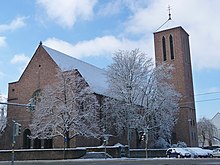Bergheim (Heidelberg)
|
Bergheim district of Heidelberg |
|
|---|---|
| Coordinates | 49 ° 24 '28 " N , 8 ° 41' 3" E |
| surface | 1.28 km² |
| Residents | 6872 (Dec. 31, 2010) |
| Population density | 5369 inhabitants / km² |
| District number | 003 |
| structure | |
| Townships |
|
| Source: City of Heidelberg (PDF; 110 kB) | |
Bergheim forms - together with the old town - the inner city of Heidelberg between the Kurfürsten-Anlage and the banks of the Neckar.
location
In the east Bergheim borders on the old town, in the south on the Weststadt and in the north on the Neckar . In the west are Wieblingen-Süd with the Rehabilitation Center (SRH) and the Pfaffengrund . The Ochsenkopf settlement already belongs to Wieblingen.
Bergheim extends along the banks of the Neckar. The centrally located Bergheimer Strasse, which defines the district area with its starting and end points, joins the 656 / Bundesstrasse 37 in the west and is bordered by Bismarckplatz in the east, is one of Heidelberg's main arteries.
In the Bergheim district there are still areas of the so-called old clinic of the university clinic (now partially converted to the Samariterhaus residential area) and Heidelberg main station . The largest employers here are Stadtwerke Heidelberg and Heidelberger Druckmaschinen AG . There are also a lot of office workplaces.
The southern boundary is the four- to six-lane Kurfürstenanlage , which begins at Bismarckplatz on the border with the old town and leads to the main train station.

history
- See also: History of Heidelberg
The former village of Bergeheim is older than the city of Heidelberg. The first traces of human settlement date from the early Stone Age. Bergheim is mentioned for the first time in a document in 769 in the Lorsch Codex .
At the Altklinikum, west of today's central Theodor-Heuss-Brücke , a Roman bridge led over the Neckar. Remnants and documentation can be found in the town's local museum .
Count Palatine Ruprecht II had Bergheim dissolved in 1392 because he wanted to expand the growing residential city of Heidelberg to the west. The villagers had to demolish their houses and move to the fortified city.
Only in the 18th century did the settlement expand again to the west out of the urban area. The new Heidelberg district was given the name of the village "Bergheim", which had been abandoned at the same location almost four hundred years earlier.
An important building in Bergheim is the Altklinikum, built by Josef Durm in the pavilion style from 1889 to 1903 , and Heidelberg's first public indoor swimming pool was also built here .
In 1949 Friedrich Wilhelm Schilling founded the Heidelberg bell foundry here.
In the formerly more industrial mountain home, renovated old apartments, university facilities, restaurants and cafes dominate today. The area along Bergheimer Strasse in particular has developed into a popular trendy district in the city due to noticeable gentrification .
Individual evidence
- ↑ Minst, Karl Josef [trans.]: Lorscher Codex (Volume 4), Certificate 2508, August 769 - Reg. 419. In: Heidelberger historical stocks - digital. Heidelberg University Library, p. 155 , accessed on February 26, 2016 .
- ↑ Old indoor swimming pool April 12, 2013


